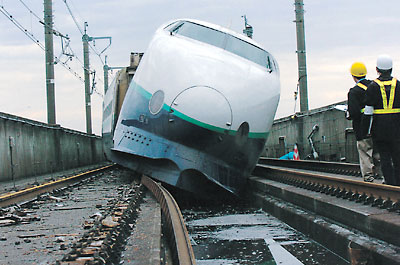|
Special Feature*
 |
|
Derailed Joetsu Shinkansen train after the earthquake in the Chuetsu region of Niigata Prefecture (October 23, 2004). This was the first derailment of a Shinkansen train since services were inaugurated in 1964.
|
Earthquake warning — Stop that bullet train!
Speedy, automatic P-wave detection
Japan's first system to stop Shinkansen trains before the ground shakes used remote seismic stations along the coast and other places to send signals to transformers if a seismograph at one of the stations oscillated more than a determined amount. But this method depended on determining the intensity of major shock waves, and the only way to know if it would stop a train before the shock hit the track was to wait for an actual quake and see.
This is why Central Japan Railway Company, which runs the Tokaido Shinkansen, introduced UrEDAS (Urgent Earthquake Detection and Alarm System) in 1992. UrEDAS seismographs pick up small seismic waves called P-waves, which reach the earth's surface before the main shock coming from the epicenter. The system immediately estimates the quake's intensity and risk areas. These two factors are used to determine risk levels where trains are running. If the risk is higher than a certain level, a signal is sent to transformers to stop the trains. The time lapse between P-wave detection and signal transmission is only three seconds.
A new UrEDAS system launched in 2004 uses the latest methods developed by the Japan Meteorological Agency to estimate earthquake intensity and other values. This has reduced the time lapse to two seconds. Before, trains were sometimes stopped even though the seismic jolt was very small, but the new system minimizes this.
|
